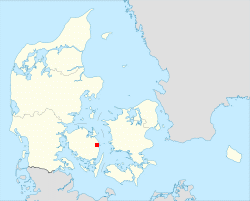 SKC Films Library SKC Films Library |
|
|
| SKC Films Library >> Fine Arts >> Architecture >> Castles and Palaces |
| Nyborg Castle Built to protect the Danish island of Funen, the oldest part of Nyborg Castle dates to around 1200.
Nyborg Castle originally consisted of a rectangular tower -- Knud's Tower -- to the east and a two-story residential section -- palatium -- to the west. The buildings were linked by a nearly 5-foot-thick surrounding wall with half-open towers in each of the four corners. Two of the original towers are now built into the castle proper, and the ground part of what used to be the residential section is now part of the cellar. Nyborg's central location made it an ideal place for King Erik Glipping to gather the Danehoffer (national assemblies at which the most powerful men in the realm would gather). Erik Glipping signed his coronation charter (the country's first constitution) there in 1282, and Constable Stig Andersen was declared an outlaw there in 1287 for murdering Erik Glipping. The last Danehof in Nyborg was in 1413, after which they were held in Copenhagen, the country's new capital. Danehofsalen, the hall which served as the venue for the assemblies, is on the ground floor next to the Great Hall. At the end of the 15th century, King Hans expanded the fortress, by extending the palatium all the way to the surrounding wall on the south side and adding an extra floor to the top of the building. The castle has been the current height ever since. King Hans regularly lived there and his son, Christian II, was born there in 1481. The fortress was badly damaged during Grevens Fejde (the Danish Civil War of 1534-36), but King Christian III commissioned his royal builder Morten Bussert to build the strongest fortress in the land as well as to expand and refurbish the fortification into a modern castle in the new Renaissance style. The palatium was extended all the way to the north wall and a turret added -- Strange's Tower -- so there was access to all the floors from the same entrance. Nyborg Castle was badly damaged again during the Dano-Swedish Wars of 1658-59. The town was occupied by Swedish troops, who stripped the castle of all its furnishings. After the Swedes had surrendered to the commander of the realm, Hans Schack, in the castle on November 14, 1659, it was in such a mess that it lost its status as an occasional royal residence, and the castle quickly began to deteriorate. In 1722, King Frederik IV ordered the remaining buildings to be torn down, with the exception of the palatium and the east tower. It was not until the start of the 20th century that there was widespread understanding of the fact that the castle ruins constituted an important part of Danish cultural heritage. From 1918-23, the Royal Inspector of Listed State Buildings, Mogens Clemmensen, organized an extensive restoration and regeneration program. As a result, the remaining features, the palatium and Knud's Tower now look approximately as they did in the mid-16th century. It has been open to the public as a museum since 1925. WEB SOURCE SEE ALSO |
SKC Films Library >> Fine Arts >> Architecture >> Castles and Palaces This page was last updated on 03/18/2017. |
